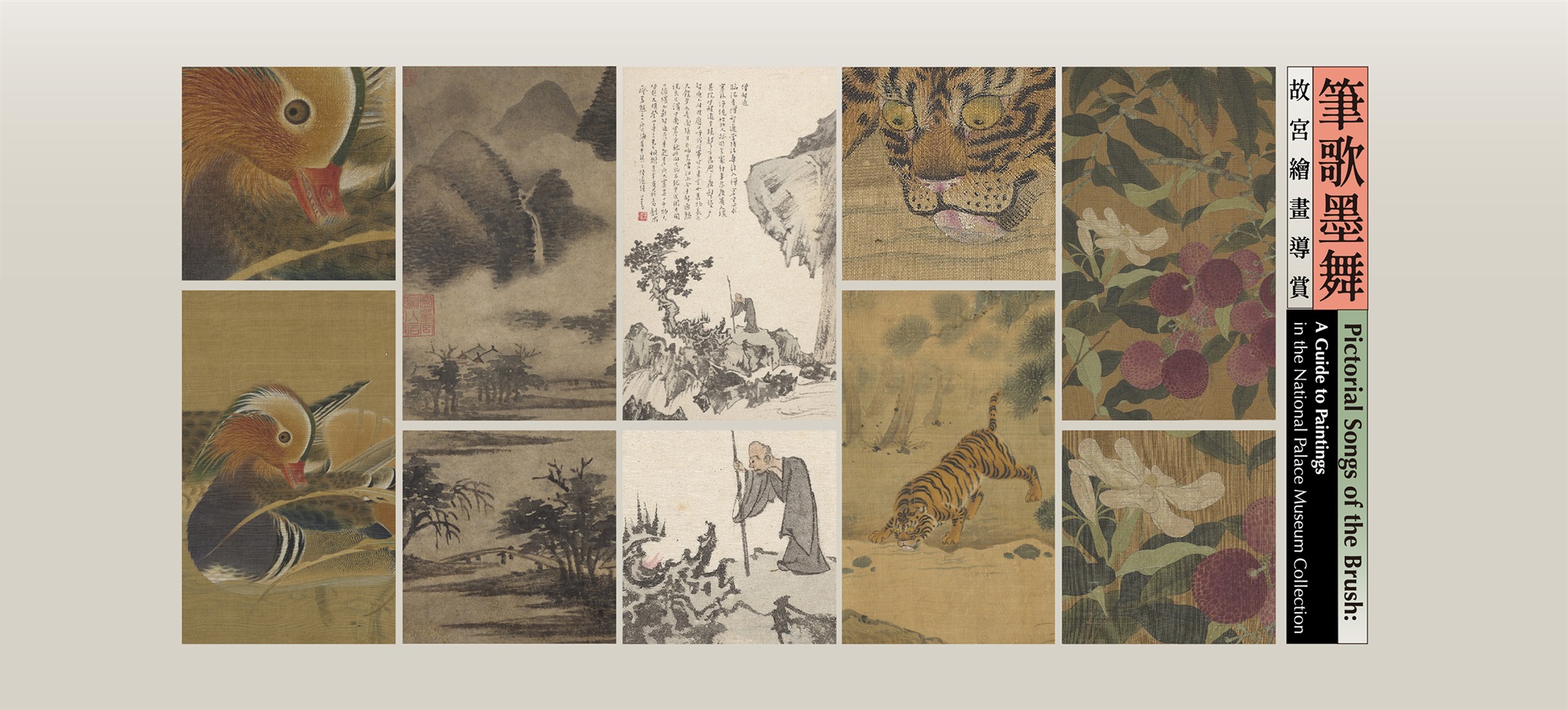Landscape Paintings
-
Contentment Amid the Mountain Clouds
Mi Youren, Song dynasty
This painting’s motif involves crowded peaks, mountainous ridges, an ocean of clouds, and alpine dwellings. Mi Youren painted only the mountaintops, treetops, and rooftops. In leaving the ground below undepicted, he portrayed the scenery seen by one who scales to high altitudes and gazes far into the distance. The contents of Mi’s own inscription written on the back of the scroll suggest that he likely painted this work prior to 1135. Some say that both the painting and the inscription on this scroll are copies, and that the work is closely related to a painting entitled “Xiaoxiang River” held by the Shanghai Museum. Others suggest that the work may reflect ways in which paintings of cloud-shrouded mountains symbolized farewells, longing to reunite with faraway relatives, or living in seclusion.
-
Painting of Mount Ying Attributred to Wang Shen
Qian Xuan, Song dynasty
The left half of this painting depicts mountainous ridges and deep valleys interspersed with alpine villages populated with thatch roofed structures. The right half portrays an immense river dotted with tiny boats. The empty expanse of the water’s surface contrasts with the precipitously soaring mountains in a composition that possesses the charms of handscrolls as well as paintings painted on multiple panels. The scenery and subject matter were rendered simply and pristinely with skillful, succinct brushwork. Texturing brushstrokes were not used with the mountains, but they were given blue-and-green coloration that bestows the painting a timelessly elegant ambience and a subtle sense of decorativeness. The date signed on this work, 1064, does not conform with Wang Shen’s actual lifetime, and its style is closer to that of Qian Xuan (1239-ca. 1301) than Wang Shen. The partial seal impression bearing the character “長” on the colophon is the same as that on Huang Tingjian’s (1045-1105) “Wind-in-the-Pines Pavilion Poems” held by the NPM, suggesting that perhaps this painting was a copy made by a young Qian Xuan for Jia Sidao (1213-1275).
-
Painting of Clouded Ridges and Soaring Waterfalls Attributed to Gao Kegong
Jin Xuan, Ming dynasty
This painting on a vertical hanging scroll employs lengthwise ink dots in place of texturing brushstrokes in order to portray a landscape of mountains and rivers. Though its dimensions are quite small, the painting’s largest mountain still has an impressive presence. The work indeed bears the stylistic marks of Gao Kegong’s (1248-1310) painting, and yet the signature is unlike Gao’s. This painting is filled with formulaic “rice grain” texturing strokes and features a Z-shaped composition replete with low-canopied trees, a scholar’s retreat, a narrow path, and a diminutive bridge. This motif, popular with literati in the region south of the Yellow River, reveals Ming dynasty (1368-1644) sensibilities. In light of these characteristics, it can be hypothesized that this work might have been painted by Jin Xuan (fl. 1403-1424), and that the poem may have been inscribed by a person who added a phony rendition of Gao Kegong’s signature. Jin Xuan, whose style name was Wending, came from Huating. He enjoyed a period of fame for his copies of landscape paintings by Gao Kegong and Huang Gongwang (1269-1354).
-
Zou Heng’s Verdant Fragrant Spring
Zhu Zongru, Ming dynasty
This painting was probably painted by Zhu Zongru (fl. 1488-1505) in 1497 for Zou Heng (1467-1506) of Jiaxing in Zhejiang province. It depicts an ancient well, which Zou Heng named the “Verdant Fragrant Spring” located beyond the gate to the prefectural seat, as well as a scholar’s retreat built beside the well. Zou Heng, who had the style name Ruping and the sobriquets “Eastern Hill” and “Simple Hut” (Dongqiu and Danyan), was the author of the Addendum to the Jiaxing Gazetteer. Following the painting he wrote an inscription explaining its origins and invited 18 individuals—including Tu Fuxun (1446-1516), Qian Fu (1461-1504), and Tang Yin (1470-1524)—to write poetic odes so as to turn the “Verdant Fragrant Spring” into a cultural attraction associated with both morality and refinement. At the same time, these poems bear witness to the way in which members of the literati engaged in poetic correspondence, while also combining their travels with literary and calligraphic activities.
-
A Farewell at Jinchang
Tang Yin, Ming dynasty
Tang Yin (1470-1524), of Suzhou, had the style name Bohu and the sobriquet Liuru (a reference to the Diamond Sutra, meaning, “like a dream, an illusion, a bubble, a shadow, a dewdrop, a flash of lightning”). He placed first in the triennial provincial imperial examinations in held in Nanjing in 1498, and is considered one of the four masters of Ming dynasty painting.
This painting depicts Suzhou literati bidding farewell to prefectural magistrate Zheng Chuzhi (ca. 15th century). The head of the scroll portrays a frost-covered forest, with glimpses of half-hidden urban dwellings, a city gate, and a faraway pagoda in the background. A bridge leading away from the city arches high over the river, boats passing beneath it as pedestrians traverse above. A mixture of officials and everyday citizens mill about at the pier, their voices joined to offer goodbyes; Zheng, at the end of the launch, has turned back to clasp his hands as he bows toward the gathered scholars. This piece melds the painting styles of Huang Gongwang (1269-1354) and Zhou Chen (ca. 1450-1535. The brushwork appears somewhat coarse, but the linework is vigorous and uplifting, a combination that lead Wang Zhideng (1535-1612) to extol in his colophon that this painting features “indulgent brushwork coupled with a transcendent spirit.”


